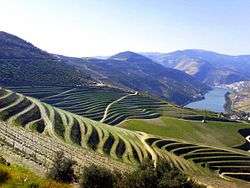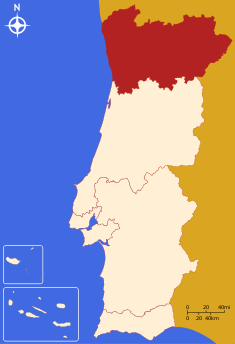Norte Region, Portugal
| Norte | |
| Região Norte | |
| NUTS II Region (Região) | |
 Upper Douro Valley, in the northeastern historical province of Trás-os-Montes e Alto Douro, where the famous port wine is produced | |
| Name origin: norte, Portuguese for north | |
| Country | |
|---|---|
| Region | North |
| Capital | Porto |
| - coordinates | PT 41°8′59″N 8°36′36″W / 41.14972°N 8.61000°WCoordinates: PT 41°8′59″N 8°36′36″W / 41.14972°N 8.61000°W |
| Lowest point | Sea level |
| - location | Atlantic Ocean |
| Area | 21,278 km2 (8,215 sq mi) |
| Population | 3,689,173 (2011) |
| Density | 173.38 / km2 (449 / sq mi) |
| Timezone | WET (UTC+0) |
| - summer (DST) | WEST (UTC+1) |
| ISO | PT |
| NUTS | PT11 |
| GDP (PPP) | 2013 estimate |
| - Total | € 61.745 billion[1] |
| - Per capita | € 16,900[1] |
| GDP (nominal) | 2013 estimate |
| - Total | € 48.148 billion[1] |
| - Per capita | € 13,200[1] |
 Location of the Norte Region
| |
| Statistics from INE (2005); geographic detail from Instituto Geográfico Português (2010) | |
Norte (Portuguese: Região Norte, IPA: [ʁɨʒiˈɐ̃w ˈnɔɾt(ɨ)]; "North Region") is a region in the northern part of Portugal. It is a land of dense vegetation and profound historic and cultural wealth. Its capital is the city of Porto. The region has 3,689,173 inhabitants according to the 2011 census,[2] and its area is 21,278 km² (density of 173 inhabitants per square kilometre). It is one of five regions of Mainland Portugal (NUTS II subdivisions). Northern Portugal is a culturally varied region, thus historical rivalries between different neighbouring cities and towns are common, unlike other Portuguese regions where every city and town is culturally very similar.
History and culture
The region has been inhabited since prehistoric times and is a key area for the understanding of both Atlantic European, Megalithic and Castro cultures. Historically, Northern Portugal had been the southern realm of Galicia (see Gallaecia), which up to the 12th century formed part of the combined Kingdom of Galicia and León, this southern area being known as the County of Portugal. It was in the County of Portugal where Portugal's first king, Dom Afonso Henriques, was born in the beginning of the 12th century. The Kingdom of Galicia at the time of the Suebic Kingdom (5th-6th centuries AD) had its capital in the now Portuguese city of Braga. The original Galician-Portuguese language was developed in the Galician/Northern Portuguese area, taken down south as the Portuguese Kingdom expanded, namely after Afonso Henriques era.
The region has a number of manor-houses and castles featuring coats of arms as an indication of a very intense medieval period. Regional cuisine is renowned and varied offering products such as light wines (vinhos verdes) and rich wines, and a variety of handicrafts that mingles the shine of filigree with the colour of the local embroideries. Northern Portugal is also very rich in folklore and traditions dating back to antiquity.
Galicia and Northern Portugal have been promoting the official candidacy for the recognition of the common intangible cultural heritage by UNESCO. The project is backed by the Galician Government, a number of Galician institutions and associations, together with local and regional governments and institutions in Northern Portugal. The official name is "Candidatura de Património Imaterial Galego-Português".
Geography
The country's longest motorway (A1, from Lisbon to Porto) goes up to Braga (A3), in the heart of Costa Verde. Following the coastline on the road from Vila do Conde to Valença, there are beaches, seaside resorts and pictoresque villages such as Caminha and Vila Nova de Cerveira. There are also scenic natural parks and mountain ranges, such as the Peneda-Gerês National Park, the Montesinho Natural Park, the Alvão Natural Park and four World Heritage Sites: the Alto Douro Wine Region, the Prehistoric Rock-Art Sites in the Côa Valley, the Porto historical Center and the Guimarães historical Center. Throughout the region the rivers, waterfalls, vineyards and fertile plots combine with the ancestral monuments in urban centres.
Subregions
Economy
Norte is highly industrialized within its densely populated western half, where well developed subregions such as Ave, Cávado, Entre Douro e Vouga, Grande Porto, and Tâmega have a notable business activity and state-of-the-art infrastructure. Textiles, footwear, food processing, mechanical, electrical, electronics and chemical industries, as well as finance and construction, are some of the main economic activities. However, the region Norte is the poorest of the 7 NUTS II regions of Portugal, with a GDP per capita of 12,648 euros or 58.8% of the European Union average. It is also the Portuguese NUTS II region with the highest unemployment rate (9.5% as of 2007). Northern Portuguese authorities have intensely promoted tourism as a means to attract external investment and further incomes in rural areas.
Northern Portugal and Galicia form a Euroregion, based on the common historical, cultural, linguistic and economic similarities. The Euroregion has its origins in the Galicia-North Portugal Work Community, established in 1991. This Euroregion is also backed by the Eixo Atlântico ("Atlantic Axis"), a lobby of Galician and Northern Portuguese cities and municipalities.
References
- Notes
- 1 2 3 4 "EU Regions" (PDF). Eurostat.
- ↑ "Censos 2011 Resultados Preliminares 2011". INE.
| ||||||||||||||||||||||||||||||||||||||||||||